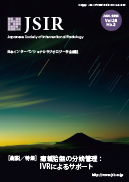最新号
選択された号の論文の12件中1~12を表示しています
- |<
- <
- 1
- >
- >|
総説/特集
癒着胎盤の分娩管理:IVRによるサポート
-
2024 年 38 巻 3 号 p. 155
発行日: 2024年
公開日: 2024/01/16
PDF形式でダウンロード (163K) -
2024 年 38 巻 3 号 p. 156-165
発行日: 2024年
公開日: 2024/01/16
PDF形式でダウンロード (2833K) -
2024 年 38 巻 3 号 p. 166-175
発行日: 2024年
公開日: 2024/01/16
PDF形式でダウンロード (2873K) -
2024 年 38 巻 3 号 p. 176-183
発行日: 2024年
公開日: 2024/01/16
PDF形式でダウンロード (1567K) -
2024 年 38 巻 3 号 p. 184-189
発行日: 2024年
公開日: 2024/01/16
PDF形式でダウンロード (561K)
症例報告
-
2024 年 38 巻 3 号 p. 190-193
発行日: 2024年
公開日: 2024/01/16
PDF形式でダウンロード (1841K)
第50回日本IVR学会総会「技術教育セミナー」
産科婦人科領域のIVR
-
2024 年 38 巻 3 号 p. 194-204
発行日: 2024年
公開日: 2024/01/16
PDF形式でダウンロード (3530K) -
2024 年 38 巻 3 号 p. 205-214
発行日: 2024年
公開日: 2024/01/16
PDF形式でダウンロード (3471K) -
2024 年 38 巻 3 号 p. 215-219
発行日: 2024年
公開日: 2024/01/16
PDF形式でダウンロード (823K)
日本IVR学会関連研究会抄録
-
2024 年 38 巻 3 号 p. 220-221
発行日: 2024年
公開日: 2024/01/16
PDF形式でダウンロード (287K) -
2024 年 38 巻 3 号 p. 222-228
発行日: 2024年
公開日: 2024/01/16
PDF形式でダウンロード (544K)
次号予告/編集後記/奥付
-
2024 年 38 巻 3 号 p. 229
発行日: 2024年
公開日: 2024/01/16
PDF形式でダウンロード (142K)
- |<
- <
- 1
- >
- >|
